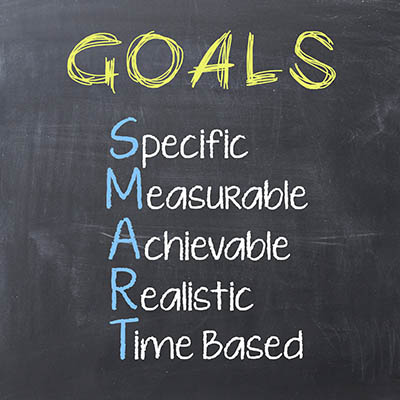
When you started your business, you had a specific goal in mind. You wanted to prove something, to create something worth sharing with the world. We all have goals and aspirations, but it’s not always clear what the best path toward those goals is. Using a simple framework, you can maximize your odds of success and set great goals that you are much more likely to achieve long-term.
Created in 1980 by George Doran, SMART goals is a framework used for fleshing out goals that are Specific, Measurable, Attainable, Relevant, and Time-Bound. The idea here is that, by defining goals based on this acronym, you will have a greater understanding of the goals you seek to achieve, as well as how to achieve them.
One thing we would like to point out before diving into what makes a SMART goal is that goal-setting and habit-forming are two different things. The two are not interchangeable; strong habits are the impetus for achieving goals. Having solid habits is but one step toward achieving a goal, although it should be said that having a strong goal can provide motivation for building a habit.
Specific
The devil is in the details, or so they say. If you can answer a series of specific questions about your goal, then you will have a much better shot at achieving it. Here are some questions to consider for making your goal more specific:
- Who is involved in making this goal a reality?
- What is it you hope to achieve?
- When do you want to work towards this goal?
- Where is your goal taking place?
- Why are you working toward this goal (this is perhaps the most important question of all)?
Measurable
A measurable goal is one that you can quantify somehow. In other words, you are using a unit of some sort to measure progress towards your goal. This might include profits earned, time spent, clients serviced, etc. You can also take this a step further by using milestones. For example, if you have a goal of replacing your office desktop solutions with new hardware, you could stagger progress toward this goal by department or units replaced.
Attainable
When asking yourself if a goal is attainable, consider just how far beyond your reach it actually is. Naturally, you don’t want to set a “safe” goal, i.e. one that you can easily achieve. While there is some merit to doing this early in the game, you should be challenging yourself and your business to extend beyond its reach. That said, your goal should not be so outlandish that it is impossible to reach. It should be just beyond your perceived ceiling.
Relevant
If a goal is relevant, this means that it is something that bleeds into more than one aspect of your organization. In other words, these goals are focused on what you truly want. This is especially helpful for getting your employees on board with the organization’s goals. If more profits mean more success for them and their careers, then they will be more likely to buy into the goals and strive to do their best to meet them.
Time-Bound
All good goals should have a concrete endpoint. Whether it is the end of the week or the end of the month, your goal should have an end date. You will either have completed your goal by this date, or you will have not completed it. You might be surprised by how much having an end date can influence your decision-making process while you are working toward the goal. You might find yourself making smarter choices, as no matter how much progress you are making, that end date creeps ever closer.
What Are Your SMART Goals?
Now that you know about SMART goals, what are some of your long-term goals to work towards? We bet some technology solutions and management from NuTech Services can help take some of the guesswork out of it. To learn more about how we can help you achieve your business-related goals, reach out to us at 810.230.9455.
